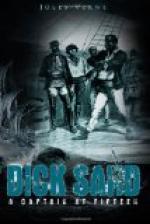This threat did not seem to frighten the giant to any great extent. However, Mrs. Weldon took him aside and told him that, perhaps, he might allow his big baby to run to the right and left, but on condition that he did not lose sight of him. It would not do to completely sever Cousin Benedict from the pleasures so natural to his age.
At seven o’clock in the morning, the little troop took up their journey toward the east, preserving the order of march that had been adopted the previous day. It was always the forest. On this virgin soil, where the heat and the moisture agreed to produce vegetation, it might well be thought that the reign of growth appeared in all its power. The parallel of this vast plateau was almost confounded with tropical latitudes, and, during certain months in summer, the sun, in passing to the zenith, darted its perpendicular rays there. There was, therefore, an enormous quantity of imprisoned heat in this earth, of which the subsoil preserved the damp. Also, nothing could be more magnificent than this succession of forests, or rather this interminable forest.
Meanwhile, Dick Sand had not failed to observe this—that, according to Harris, they were in the region of the pampas. Now, pampas is a word from the “quichna” language, which signifies a plain. Now, if his recollections did not deceive him, he believed that these plains presented the following characteristics: Lack of water, absence of trees, a failure of stones, an almost luxuriant abundance of thistles during the rainy season, thistles which became almost shrubby with the warm season, and then formed impenetrable thickets; then, also, dwarf trees, thorny shrubs, the whole giving to these plains a rather arid and desolate aspect.
Now, it had not been thus, since the little troop, guided by the American, had left the coast. The forest had not ceased to spread to the limits of the horizon. No, this was not the pampas, such as the young novice had imagined them. Had nature, as Harris had told him, been able to make a region apart from the plateau of Atacama, of which he knew nothing, if it did not form one of the most vast deserts of South America, between the Andes and the Pacific Ocean?
On that day Dick Sand propounded some questions on this subject, and expressed to the American the surprise he felt at this singular appearance of the pampas.
But he was quickly undeceived by Harris, who gave him the most exact details about this part of Bolivia, thus witnessing to his great knowledge of the country.
“You are right, my young friend,” he said to the novice. “The true pampa is indeed such as the books of travels have depicted it to you, that is, a plain rather arid, and the crossing of which is often difficult. It recalls our savannahs of North America—except that these are a little marshy. Yes, such is indeed the pampa of the Rio Colorado, such are the “llanos” of the Orinoco and of Venezuela. But here, we




